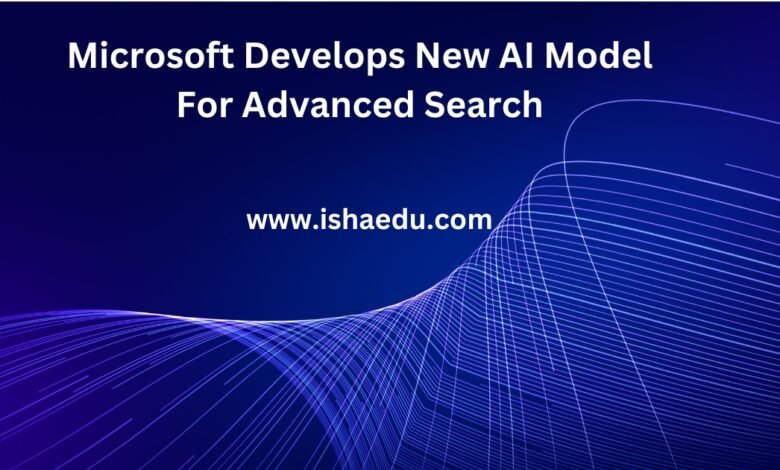Microsoft Develops New AI Model For Advanced Search

Microsoft Develops New AI Model For Advanced Search
Microsoft has embarked on a groundbreaking venture in the realm of search technology, crafting a formidable Large Language Model (LLM) known as MAI-1. This initiative is set to rival the likes of Google’s LaMDA and OpenAI’s GPT-3, marking a pivotal moment in the evolution of search engines.
LLMs, the backbone of this transformation, are AI powerhouses trained extensively on vast troves of textual data.
Their emergence promises to revolutionize web searches in several key aspects:
- Understanding Search Intent: MAI-1 and its counterparts possess the ability to dissect search queries, discerning their underlying meanings and the actual information sought by users. This holds the potential to deliver more pertinent and actionable search results, transcending mere keyword matching. Imagine querying “climate change solutions” and receiving not just scientific reports but also actionable steps individuals can take.
- Enhanced Search Accuracy: By deciphering user intent, LLMs stand to enhance the accuracy of search outcomes. Search engines may anticipate user needs, even amidst imperfectly phrased queries. This could translate to reduced sifting through irrelevant results and more time spent accessing relevant information.
- Revolutionizing Search Features: The advent of LLMs opens doors to entirely novel search experiences. Picture posing complex questions to a search engine and receiving concise, conversational responses. Alternatively, envision receiving tailored summaries catering precisely to your informational requirements, such as key points distilled from lengthy research papers.
- Catalyzing Search Innovation: Microsoft’s foray into the LLM arena is poised to stimulate innovation across established search engines like Bing and Yahoo. This competitive impetus could yield advancements in various domains, including:
- Search Result Ranking: Prioritizing results based not just on relevance but also on credibility and trustworthiness.
- Personalization: Tailoring search outcomes to individual user histories and preferences.
- Multilingual Capabilities: Improving search engines’ proficiency in understanding and responding to queries across diverse languages.
Microsoft’s development of MAI-1 heralds a future where advanced AI underpins the search experience. This promises a more intuitive and informative journey, with search engines adept at anticipating user needs and furnishing comprehensive results.
Moreover, the influence of LLMs on the search landscape extends beyond conventional realms:
- Knowledge Graphs: LLMs could bolster the construction of expansive knowledge graphs, facilitating a deeper understanding of interconnected concepts and furnishing more relevant results.
- Voice Search: Enhancing the accuracy and natural language comprehension of voice-enabled search assistants, simplifying information retrieval through spoken language.
- Visual Search: Leveraging LLMs to enhance the capabilities of visual search engines, enabling users to seek information by uploading images or capturing photos.
While the development of LLMs remains in its nascent stages, its potential to reshape online information retrieval is undeniable. With Microsoft’s entry into the fray, we can anticipate a surge of innovation in the years ahead.

FAQs
What is the new AI bought by Microsoft?
Microsoft developed its new AI model, MAI-1, to compete with others in the field. It’s a large language model, not something they acquired.
What is Microsoft AI search?
Microsoft has two ways they use AI for search:
- Bing: Their search engine with AI-powered features.
- Azure AI Search: A service for businesses to build custom search experiences.
What is the new Microsoft browser with AI?
Microsoft doesn’t have a separate AI browser, but their existing browser, Microsoft Edge, has built-in AI features called “Copilot” that can help you with various tasks while browsing the web. These features include things like summarizing complex web pages or helping you compose content.
Who owns ChatGPT?
ChatGPT is owned by OpenAI, an artificial intelligence research laboratory. OpenAI is a for-profit company, although it started out as a nonprofit. They focus on friendly AI, meaning they aim to develop artificial intelligence in a way that benefits humanity.
Why is Microsoft using AI?
Microsoft uses AI to make its products and services smarter, like helping you find what you’re looking for online or improving features in its software.
Is Microsoft a leader in AI?
Microsoft is a major player in AI, with big investments in research and development. Their AI is used in products like Azure and Microsoft 365. They’re considered a leader, but other companies like Google and Amazon are also strong competitors.
Is Microsoft Copilot generative AI?
es, Microsoft Copilot is a generative AI tool. It uses machine learning to analyze your code and suggest completions or next steps tailored to your work. This can help you be more productive and creative.
Generative AI is a type of AI that can create new content, like text, code, or images. It’s behind many of the new AI features you see these days.

مائیکروسافٹ نے جدید تلاش کے لیے نیا مصنوعی ذہانت (AI) ماڈل تیار کیا ہے
Microsoft نے تلاش کی ٹیکنالوجی کے میدان میں ایک انقلابی قدم بڑھایا ہے، جس نے ایک مضبوط لارچ لینگویج ماڈل (LLM) تیار کیا ہے جسے MAI-1 کہتے ہیں۔ یہ پہل گوگل کے LaMDA اور OpenAI کے GPT-3 جیسے مقابلوں کو للکارنے کے لیے تیار ہے، جو تلاش کی دنیا میں ایک اہم موڑ کی نشان دہی کرتی ہے۔
LLM، اس تبدیلی کی ریڑھ کی ہڈی، وسیع مقدار کے متن کے ڈیٹا پر وسیع پیمانے پر تربیت یافتہ AI پاور ہاؤسز ہیں۔
ان کا ظہور انٹرنیٹ تلاش کو متعدد کلیدی پہلوؤں میں انقلاب کا وعدہ کرتا ہے:
تلاش کی نیت کو سمجھنا: MAI-1 اور اس کے ہم منصب تلاش کی پوچھ گچھ کو پرکھنے کی صلاحیت رکھتے ہیں، ان کے بنیادی معنی اور صارفین کی طرف سے مطلوبہ اصل معلومات کو سمجھتے ہیں۔ یہ زیادہ متعلقہ اور قابل عمل تلاش نتائج فراہم کرنے کی صلاحیت رکھتا ہے، جو صرف کلیدی الفاظ سے مطابقت سے آگے ہے۔ “آب و ہوا میں تبدیلی کے حل” کے بارے میں پوچھ گچھ کرنے اور نہ صرف سائنسی رپورٹوں بلکہ انفرادی طور پر قابل عمل اقدامات بھی موصول ہونے کا تصور کریں۔
تلاش کی درستگی میں اضافہ: صارف کی نیت کو سمجھنے کے ذریعے، LLM تلاش کے نتائج کی درستگی کو بڑھانے کے لیے کھڑے ہیں۔ تلاش کے انجن صارفین کی ضروریات کا اندازہ لگا سکتے ہیں، یہاں تک کہ غیر واضح طور پر بیان کیے گئے پوچھ گچھ کے درمیان بھی۔ اس کا مطلب یہ ہو سکتا ہے کہ غیر متعلقہ نتائج کو چھانٹنے میں کم وقت لگے اور متعلقہ معلومات تک رسائی میں زیادہ وقت صرف ہو۔
تلاش کی خصوصیات میں انقلاب: LLM کی آمد بالکل نئے تلاش کے تجربے کے دروازے کھولتی ہے۔ ایک تلاش کے انجن سے پیچیدہ سوالات پوچھنے اور مختصر، گفتگو والے جوابات حاصل کرنے کا تصور کریں۔ اس کے بجائے، اپنی معلومات کی ضروریات کے عین مطابق تیار کیے گئے خلاصے موصول ہونے کا تصور کریں، جیسے کہ طویل تحقیقی مقالوں سے نکالے گئے اہم نکات۔
تلاش میں جدت کو فروغ دینا: LLM میدان میں مائیکروسافٹ کی شمولیت سے بنگ اور یاندکس جیسے موجودہ تلاش کے انجنوں میں جدت کو فروغ ملنے کی صلاحیت ہے۔ یہ مقابلتی محرک مختلف شعبوں میں ترقی کا باعث بن سکتا ہے، بشمول:
تلاش کے نتائج کی درجہ بندی: نتائج کو نہ صرف متعلقہ بلکہ اعتبار اور اعتماد کے لحاظ سے بھی ترجیح دینا۔
ذاتی نوعیت: تلاش کے نتائج کو انفرادی صارف کی تاریخ اور ترجیحات کے مطابق بنانا۔
کثیر زبان صلاحیت: تلاش کے انجنوں کی مختلف زبانوں میں پوچھ گچھ کو سمجھنے اور ان کا جواب دینے کی مہارت میں
اکثر پوچھے گئے سوالات
مائیکروسافٹ نے کون سی نئی مصنوعی ذہانت (AI) خریدی ہے؟
مائیکروسافٹ نے میدان میں موجود دیگر کمپنیوں کا مقابلہ کرنے کے لیے اپنا نیا AI ماڈل، MAI-1 خود تیار کیا ہے۔ یہ ایک بڑا لینگویج ماڈل ہے، نہ کہ کوئی ایسی چیز ہے جسے انہوں نے خریدا ہے۔
مائیکروسافٹ AI تلاش کیا ہے؟
مائیکروسافٹ تلاش کے لیے AI کو دو طریقوں سے استعمال کرتا ہے:
بنگ: ان کا سرچ انجن جو AI سے چلنے والی خصوصیات سے لیس ہے۔
Azure AI Search: کاروباروں کے لیے اپنی مرضی کے مطابق تلاش کے تجربات بنانے کے لیے ایک سروس۔
مائیکروسافٹ کا نیا AI براؤزر کیا ہے؟
مائیکروسافٹ کے پاس الگ سے کوئی AI براؤزر نہیں ہے، لیکن ان کے موجودہ براؤزر، مائیکروسافٹ ایج میں، “کوپائیلیٹ” نامی AI خصوصیات شامل ہیں جو آپ کی ویب براؤزنگ کے دوران مختلف کاموں میں مدد کر سکتی ہیں۔ ان خصوصیات میں پیچیدہ ویب صفحات کو س خلاصہ کرنا یا مواد لکھنے میں آپ کی مدد کرنا شامل ہے۔
ChatGPT کی ملکیت کس کے پاس ہے؟
ChatGPT کی ملکیت OpenAI کے پاس ہے، جو ایک تحقیقاتی آزمایش گاہ ہے جو مصنوعی ذہانت (AI) پر کام کرتی ہے۔ OpenAI ایک منافع بخش کمپنی ہے، حالانکہ یہ ایک غیر منافع بخش تنظیم کے طور پر شروع ہوئی تھی۔ وہ “دوست” AI پر توجہ مرکوز کرتے ہیں، جس کا مطلب ہے کہ ان کا مقصد مصنوعی ذہانت کو اس طریقے سے تیار کرنا ہے جو انسانیت کے لیے فائدہ مند ہو۔
مائیکروسافٹ AI کیوں استعمال کر رہا ہے؟
مائیکروسافٹ اپنے مصنوعات اور خدمات کو زیادہ ہوشیار بنانے کے لیے AI کا استعمال کرتا ہے، جیسے آپ کو آن لائن تلاش کرنے میں مدد کرنا یا اس کے سافٹ ویئر کی خصوصیات کو بہتر بنانا۔
کیا مائیکروسافٹ AI کا رہنما ہے؟
مائیکروسافٹ AI کے شعبے میں ایک اہم کردار ہے، تحقیق اور ترقی میں بڑی سرمایہ کاری کے ساتھ۔ ان کی AI کا استعمال Azure اور Microsoft 365 جیسی مصنوعات میں کیا جاتا ہے۔ انہیں ایک رہنما سمجھا جاتا ہے، لیکن گوگل اور Amazon دیگر کمپنیاں بھی مضبوط حریف ہیں۔
کیا مائیکروسافٹ کوپائیلیٹ جنریٹو AI ہے؟
ہاں، مائیکروسافٹ کوپائیلیٹ ایک جنریٹو AI ٹول ہے۔ یہ آپ کے کوڈ کا تجزیہ کرنے اور آپ کے کام کے مطابق تجاویز یا اگلے اقدامات تجویز کرنے کے لیے مشین لرننگ کا استعمال کرتا ہے۔ یہ آپ کو زیادہ پُیداوار اور تخلیقی بننے میں مدد کر سکتا ہے۔
جنریٹو AI ایک قسم کی AI ہے جو نیا مواد، جیسے متن، کوڈ یا تصاویر تخلیق کر سکتی ہے۔ یہ اس وقت بہت سی نئی AI خصوصیات کے پیچھے ہے۔

Join Us :
Click Here To Get Technology And Entertainment Notification:




